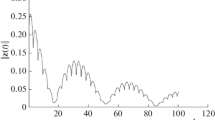Abstract
It is shown that given a switched linear control system which satisfy the controllability rank condition, it is possible to construct a non-switched homogenous polynomial control system in such a way that the trajectories of the latter may be arbitrarily well approximated norm on finite time intervals.
Similar content being viewed by others
References
S.M. Williams, R.G. Hoft. Adaptive frequency domain control of PPM switched power line conditioner[J]. IEEE Trans. on Power Electronics, 1991, 6(4): 665–670.
L.M. Smith. Playas of the Great Plains[M]. Austin: University of Texas Press, 2003.
M.S. Branicky. Multiple Lyapunov functions and other analysis tools for switched and hybrid systems[J]. IEEE Trans. on Automatic Control, 1998, 43(4): 475–482.
W.P. Dayawansa, C.F. Martin. A converse Lyapunov theorem for a class of dynamical systems which undergo switching[J]. IEEE Trans. on Automatic Control, 1999, 44(4): 751–760.
D. Liberzon, A.S. Morse. Basic problems in stability and design of switched systems[J]. IEEE Control systems, 1999, 19(5): 59–70.
K.A. Loparo, J.T. Aslanis, O. IIajek. Analysis of switching linear systems in the plain, part 2, global behavior of trajectories, controllability and attainability[J]. J. of Optimization Theory and Applications, 1987, 52(3): 395–427.
J. Ezzine, A.H. Haddad. Controllability and observability of hybrid systems[J]. Int. J. of Control, 1989, 49(6): 2045–2055.
F. Szigeti. A differential-algebraic condition for controllability and observability of time varying linear systems[C] // Proc. of the 31st Conf. on Decision and Control. New York: IEEE Press, 1992: 3088–3090.
Z. Sun, S.S. Ge, T.H. Lee. Controllability and reachability criteria for switched linear systems[J]. Automatica, 2002, 38(5): 775–786.
V. Jurdjevic and I. Kupka. Polynomial control systems[J]. Mathematische Annalen, 1985, 272(3): 361–368.
A. A. Agrachev and Yu. L. Sachkov. Control Theory from the Geometric Viewpoint[M]. Berlin: Springer-Verlag, 2004.
W. P Dayawansa, C. F Martin, S. Samelson. Asymptotic stabilization of a generic class of three dimensional homogeneous quadratic systems[J]. Systems & Control Letters, 1995, 24(2): 115–123.
L. D. Drager, R. L. Footel, C. F. Martin1, J. Wolper. Controllability of linear systems, differential geometry curves in grassmannians and generalized grassmannians, and riccati equations[J]. Acta Applicandae Mathematicae: An International Survey Journal on Applying Mathematics and Mathematical Applications, 1989, 16(3): 281–317.
P. E. Crouch, C. I. Byrnes. Local accessibility, local reachability, and representations of compact groups[J]. Mathematical Systems Theory, 1986, 19(1): 43–65.
J. Stoer, R. Bulrisch. Introduction to Numerical Analysis[M]. New York: Springer-Verlag, 1980.
R.W. Brockett. Asymptotic stability and feedback stabilization[M]. // R.W. Brockett, R.S. Millmann, H.J. Sussmann, Eds. Differential Geometric Control Theory. Boston: Birkhäuser, 1983: 181–191.
Author information
Authors and Affiliations
Additional information
This work was partially supported by the National Science Foundation(No. ECS-0220314, ECS-0218245) and the Environmental Protection Agency.
P. C. PERERA received his B.Sc. in Electrical Engineering from University of Peradeniya, Sri Lanka, in 1999, and Ph.D. in Mathematics from Texas Tech University, Lubbock, Texas in 2003. Since then, he has been a senior lecturer at the Faculty of Engineering, University of Peradeniya, Sri Lanka. His research interests include switched control systems, mathematical systems theory and genetic algorithms. He is the secretary of the Central Region subsection of the IEEE, Sir Lanka.
W. P. DAYAWANSA was born in Sri Lanka. He received his B.S. in Electrical Engineering from the University of Peradeniya, Sri Lanka in 1978, M.S. in Electrical Engineering from the Clarkson University in 1982, and S.D. in Systems Science and Mathematics from the Washington University in 1986. He held positions as Assistant Professor in Mathematics at the Texas Tech University (1986–1989), Assistant Professor in Electrical Engineering and the Institute for Systems Research at the University of Maryland, College Park (1989–1992), Associate Professor in Electrical Engineering and the Institute for Systems Research at the University of Maryland, College Park (1992–1996), and Professor of Mathematics at the Texas Tech University (1996–). He is currently a Paul Whitfield Horn Professor in Mathematics at the Texas Tech University. His research interests are primarily in the areas of nonlinear control systems, control aspects of the neuro-muscular system, and control of microelectromechanical systems. He is a Fellow of the IEEE.
Rights and permissions
About this article
Cite this article
Perera, P.C., Dayawansa, W.P. Approximation of a switched linear system by a nonswitched homogeneous polynomial system. J. Control Theory Appl. 4, 3–10 (2006). https://doi.org/10.1007/s11768-006-5319-5
Received:
Revised:
Issue Date:
DOI: https://doi.org/10.1007/s11768-006-5319-5




